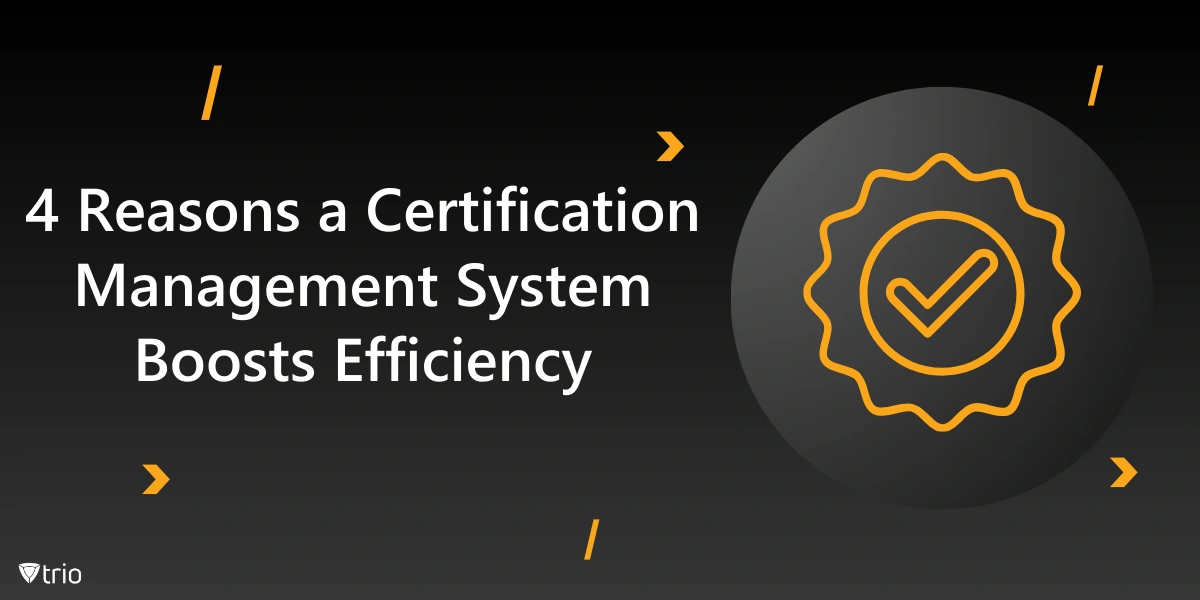A lot of organizations struggle with managing their certificate management process effectively. Handling certifications manually is not only time-consuming but also increases the risk of errors, leading to compliance issues and operational setbacks.
A certificate management system with compliance automation streamlines the entire process. It automates tasks like renewals and reminders, ensures all certifications are up-to-date, and maintains comprehensive documentation. This centralization reduces manual workload and minimizes the chance of overlooking critical certifications, enhancing overall efficiency.
In today’s fast-paced environment, efficient certification management solutions are essential to stay competitive and secure. In this blog, we’ll explore four key reasons why implementing a certification management system can significantly boost your organization’s efficiency and reduce potential risks.
Reason 1: Streamlined Certification Processes
Managing certifications can be a real hassle, but a certification management system makes it much smoother. Let’s explore how it boosts efficiency.
Automation of Tasks
Imagine never worrying about certification renewals again! With certificate lifecycle management tools, renewing certifications becomes effortless. The system automatically handles renewals, sends out timely reminders, and keeps all your documentation in order. This automation significantly cuts down your manual workload and minimizes error rates, ensuring everything stays up to date without stress.
Centralized Management
Keeping all your certifications organized is a breeze with a cloud-based certificate management tool. It allows you to manage certificates from one accessible system, enhancing overall organization. Administrators can easily access and oversee all certifications without digging through multiple files or platforms. This centralized approach not only saves time but also ensures that everything is securely stored and readily available when needed.
Reason 2: Enhanced Compliance and Risk Management
Staying compliant is crucial, and a certification management system has your back. Let’s see how it keeps everything in check.
Ensuring Regulatory Compliance
A Management System Certification ISO ensures you meet industry standards and legal requirements. The system works closely with your certification body to navigate various types of compliance effortlessly. Utilizing public key infrastructure (PKI), it automates essential compliance tasks, reducing the chance of human error. Features like automated audits and real-time tracking make adhering to regulations straightforward, so you can focus on what you do best without worrying about missing a compliance beat.
Minimizing Risks
Avoid hefty fines and data breaches by effectively managing your TLS certificate and SSL certificate. The system keeps an eye on all digital certificates, ensuring each signed certificate and certificate signing request (CSR) is valid throughout its validity period. By proactively monitoring these elements, it identifies potential compliance issues early on, reducing the risk of non-compliance penalties. This approach not only protects your organization from unexpected vulnerabilities but also ensures continuous adherence to compliance standards, giving you peace of mind.

Reason 3: Improved Visibility and Reporting
Having a clear view of your certifications is a game-changer. Let’s see how enhanced visibility and robust reporting can make a big difference.
Real-Time Insights
With top-notch certificate management software, you gain access to up-to-date information on all your certifications. Dashboards provide real-time tracking, so you always know the status of each certificate. This immediate visibility helps you spot issues before they become problems, ensuring that nothing slips through the cracks and maintaining smooth operations.
Comprehensive Reporting
Using the best certification management system, generating detailed reports becomes effortless. These reports are invaluable for audits and informed decision-making. They support strategic planning and performance evaluation by offering insights into certification trends and compliance statuses. Reliable reporting features help you stay prepared and make data-driven choices that enhance your organization’s efficiency and effectiveness.
Reason 4: Better Integration with Existing Systems
Integrating new tools shouldn’t feel like fitting a square peg in a round hole. A certification management system seamlessly blends with your current setup, making everything run smoother.
Seamless Integration With MDM Solutions
A cloud-based certification management system effortlessly connects with Mobile Device Management (MDM) solutions. This unified management across platforms ensures that all your devices adhere to the same certification standards. The advantage? Streamlined operations and consistent security policies, reducing the risk of mismatches or overlooked certifications on any device.
Compatibility With Other Software
Even a free certification management system can integrate smoothly with HR software, learning management systems, and more. This compatibility boosts overall organizational efficiency and ensures data consistency across all platforms. By linking different tools, you eliminate data silos and create a cohesive workflow, making it easier to manage certifications alongside other critical business functions.
Trio: Your Perfect MDM Partner
Our cloud-based MDM solution, Trio, seamlessly integrates into your digital workspace, working hand-in-hand with certification management systems. This unified approach ensures that all your devices adhere to consistent certification standards, enhancing security and operational efficiency. With Trio, monitoring and enforcing certifications in real-time becomes effortless, reducing the risk of security gaps and ensuring your digital workspace remains compliant.
Ready to see Trio in action? Take advantage of our free demo to explore how it can transform your certification management. Trio not only synchronizes data and streamlines workflows but also fits smoothly with your existing software, boosting overall organizational efficiency. Whether you’re managing a few devices or scaling up, Trio provides a secure, compliant environment tailored to your needs.
Steps to Implement a Certification Management System Successfully
Implementing a certification management system doesn’t have to be overwhelming. Follow these steps to ensure a smooth transition.
Assessment
Start by evaluating your organization’s specific needs and current challenges using a certification management system template. Identify gaps in your processes and determine certificate management best practices that address these issues. This assessment ensures your certification program aligns with your goals and supports continual improvement.
Selection and Training
Choose a system that fits your requirements and offers scalability for future growth. Invest in developing management skills through comprehensive training for your staff, including compliance training to ensure everyone understands regulatory standards. Providing ongoing support is crucial for smooth operation, fostering a culture of continual improvement and maximizing the system’s effectiveness in your organization.

Wrapping It All Up
In summary, the best certification management system streamlines processes, ensures compliance, enhances visibility, and integrates seamlessly with your MDM solutions, boosting organizational efficiency and customer satisfaction.
Know about news
in your inbox
Our newsletter is the perfect way to stay informed about the latest updates,
features, and news related to our mobile device management software.
Subscribe today to stay in the know and get the most out of your mobile
devices with our MDM solution app.
Recent Posts

Erase the Risk: Protect with Zero Standing Privileges
Learn how zero standing privileges eliminate persistent access rights, enhance data security and reduce the risk of unauthorized access.

Understanding Access Control Types in Cybersecurity w/ Examples
Thorough understanding of access control types & the knowledge to make informed decisions about implementing security measures in your organization.

Cloud Data Protection: Safeguarding Information in the Cloud
Learn essential strategies for robust cloud data protection, exploring tools, best practices, and policies that safeguard sensitive information.





